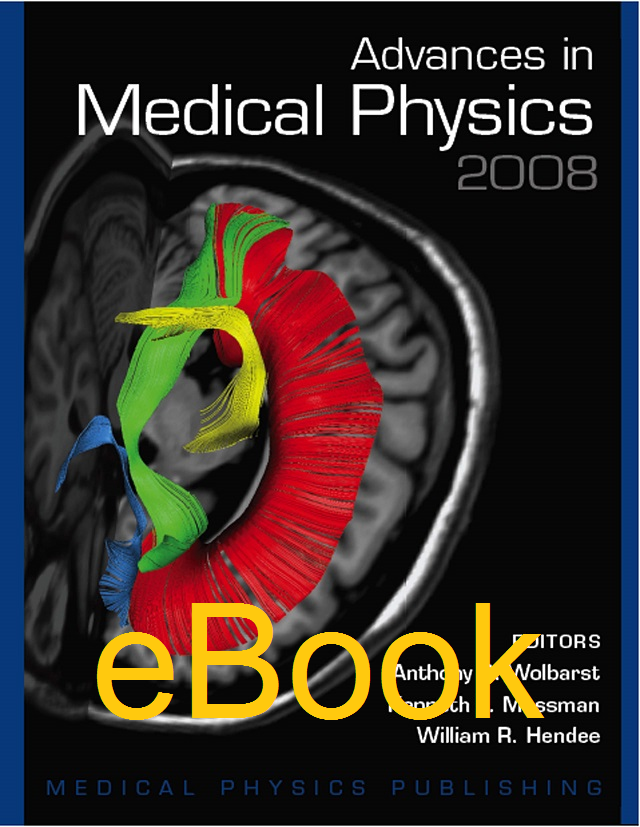
Advances in Medical Physics: 2008
Author: Anthony B. Wolbarst, Kenneth L. Mossman, and William R. HendeeISBN: 9781930524781
Published: 2008 | 368 pp. | eBook
Price: $ 94.00
Health Physics | June 2009, Vol. 96, No. 6
Advances in Medical Physics first appeared in 2006 with the intent to assist medical physicists, physicians and "and in particular the subfields of medical physics other than." This is the second of the series that addresses therapy and diagnostic medical physics. The third publication divides into advances in medical physics: diagnostic imaging published in the even-numbered years and odd-numbered years, and advances in medical physics: radiation therapy in the odd-numbered years.
The subjects covered in the text are: digital radiography, image display systems, computed tomography (CT) positron emission tomography (PET) reconstruction algorithms, CT quality control, CT doses, magnetic resonance imaging (MRI) update, the principles of quantitative MRI, molecular imaging, finite training of radiologists, compter-aided detection/computer diagnosis, health risks from low doses of ionizing radiation, image-guided radiation therapy, stereotactic radiosurgery, treatment plan optimization, therapy vault shielding design, regulations in medicine, statistical modeling of clinical studies, and a description of the grant process in the National Institute of Biomedical Imaging and Bioengineering (NIBIB) at the National Institutes of Health (NIH). The 2008 edition strongly emphasizes imaging medical physics with ten chapters followed by radiation therapy with four chapters. Nuclear medical physics and health physics each have one chapter, along with statistical modeling and NIBIB. Thus, eighteen chapters discuss material in 335 pages. As stated in the preface of the book, roughly 20 pages per topic is a reasonable summary of the subjects covered in the publication.
The review of digital radiography, mammography, and fluoroscopy by J. Anthony Seibert is well written, concise, and covers the subject area well, including references for a description of quality assurance and acceptance testing as well as providing references for delving into the subject in greater depth. This approach is not only valuable for medical physicists outside of the subject area, but also a good starting point for medical physicists pursuing board certification. On the other hand, the chapter on MRI update describes hardware developments and software and advanced application developments, but does not offer guidelines for quality control or quality improvement.
The chapter on stereotactic radiosurgery covers the wide topic in good depth for the allotted number of pages, but is light on quality assurance/plan verification. The measurement techniques for small beam dosimetry, as well as the review of dose delivery systems are covered well with a good reference selection. Perhaps one of the most practical chapters in this textbook is the introduction to therapy vault shielding design in accordance with the National Council on Radiation Protection and Measurements (NCRP) Report No. 151 (NCRP 2005). The material is presented clearly with minimal chance of misinterpretation and is well referenced.
The most complex topic is addressed by Donald E. Herbert in Some Perspective and Insights in Modern Statistical Modeling, with a chapter covering over 40 pages of the text. This chapter is in depth, complex, and extremely well delivered. The topics range from the introduction to models, the selection of the most appropriate model, the delineation of the three principal models used for analyzing sets that commonly confront medical physicists, which are the general linear model, the nonlinear regression model and the generalized linear model. Herbert goes on to discuss the properties of parameter estimates in the aforementioned models as well as model averaging. This is then followed by an in-depth discussion of inference models, including the name and height of the Pearson, the Bayes model, the information theory model, and models for the future. As always, Herbert follows Confucius' proverb of "Know what you know and know what you don't know."
In summary, the textbook is an excellent coverage for a review of topics in diagnostic medical physics and radiation therapy medical physics. It is, of course, limited by the finite resources allotted to 18 topics. The authors are all entirely drawn from within the United States. Future editions would benefit from contributions from other countries and cultures. Increased depth and breadth improvement appears to be realized with the future policy dividing the publications into biennial reports alternating diagnostic medical physics and therapy medical physics. I am positive that the addition of future volumes will amount to an excellent library of medical physics reviews.
Michael C. Schell
Radiation Oncology
University of Rochester


